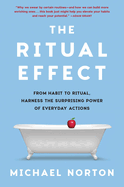
Many people use the words "habit" and "ritual" interchangeably, but Michael Norton, Harvard Business School behavior scientist and behavioral economics researcher, argues convincingly that they are very different things. A habit is an automatic, routine action; rituals are more spiritually valuable, he writes, serving as "emotional catalysts that energize, inspire, and elevate us." In his first non-academic book, The Ritual Effect, Norton presents an engaging and commonsense précis of his research into rituals, making a strong case for their importance in the personal and professional spheres as people mark milestones, form relationships, or simply "savor the experiences of everyday life."
Rituals used to be considered the purview of religion, Norton--who grew up in an Irish Catholic family--acknowledges, but in our less sacred time, he believes they are still essential. In the 1890s, sociologist Max Weber first warned of the "disenchantment" of a technologically modern age. Science may have demystified the workings of the world, but it cannot fully satisfy the human search for meaning and wonder. This is where secular rituals come in. "Rituals animate us, enhancing and enchanting our lives with something more," Norton asserts.
Norton and his team of researchers have interviewed tens of thousands of Americans about their reliance on rituals. He has discovered that rituals can be inherited from a particular culture or family, or spontaneously generated by individuals. They might not make any sense to outsiders. For instance, pianist Sviatoslav Richter never went on stage without his pink plastic lobster nearby. Mystery writer Agatha Christie closed each day by eating an apple in the bath (thus providing the book's intriguing cover image).
"The less practical the action is, the riper it is for a ritual interpretation," says Norton. Following psychologist Dan Wegner, he draws a distinction between what people literally do--which might strike others as random--and what they think they are accomplishing. Building on what Rohan Kapitány and Mark Nielsen called "the ritual stance," Norton asserts that one can interpret arbitrary actions as having emotional significance. An athlete might perform a bewildering sequence of taps, bounces, or touches before going onto the field or court, in an attempt to calm down or, alternatively, gear up for focused play. Rituals can also help performers cope with failure, Norton suggests, but if they go too far and the ritual becomes an obsession--if someone cannot execute their role at all without following certain exact steps--that can interfere with a career.
It is possible to turn any habit into a ritual through attitude and intentionality. If habit addresses the question of "what," ritual takes care of the "how," investing common activities with meaning. Two examples he gives are the average morning routine--showering, brushing teeth, and making coffee--which can be completed either robotically, just to get the tasks done, or in a precise order and with the mindset of wanting to start the day off right; and the weekly food shop, which couples might regard as drudgery but could instead view as an opportunity to spend quality time together.
The Ritual Effect has a logical structure, moving from a general discussion of ritual to the benefits for individuals, relationships, and businesses or nations. Particularly enjoyable is the chapter entitled "How to Savor," which goes deeper into food and drink rituals such as dinner parties, becoming immersed in wine culture, or just sharing a glass of wine. There is a huge difference, Norton notes, between being nourished by a scientifically formulated nutritional product like Soylent and dining well. For families, he suggests, holiday rituals, which often revolve around food and drink, are a way of saying "This is who we are." Even a family dinner can serve to reinforce those bonds.
By contrast, rituals can also commemorate endings. Norton recounts the bizarre story of how performance artists Ulay and Marina Abramović marked their break-up in dramatic fashion by walking the Great Wall of China from opposite ends, briefly meeting in the middle to embrace, and then continuing their separate ways. Death, of course, has sparked a wide range of mourning rituals, varying by culture, and influenced or interrupted by wartime and pandemics.
In the same way that individuals can celebrate beginnings and endings--rites of passage or acts of farewell--organizations and countries can encourage mass rituals that build solidarity. Workplaces might introduce team-building activities to "enliven the mundanity and monotony." Sports can bring people together across political rifts. In South Africa, reconciliation rituals have helped the nation to heal from the aftermath of apartheid. On a smaller scale, blended families or merged companies can create new rituals to bridge divides.
The book is comprehensive, covering every possible subtopic but never overwhelming readers because of its digestible sections and handy explanations of theories from psychology and other fields. Norton's absorbing narrative is packed with fascinating examples, and he shows how we can create simple rituals to enhance human lives. This is an accessible, practical work that deftly blends science and self-help, and is sure to attract fans of Malcolm Gladwell and Gretchen Rubin. --Rebecca Foster

